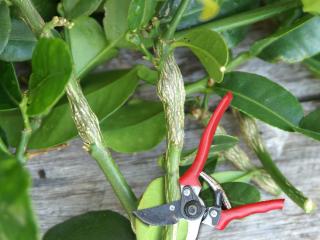Perth gardeners are reminded to monitor their citrus trees and have pruners at the ready to control the destructive pest, citrus gall wasp.
Citrus gall wasp attacks all types of citrus trees, reducing the amount of fruit produced and in severe cases can cause tree dieback.
The Department of Primary Industries and Regional Development and industry group WA Citrus are appealing to citrus tree owners to implement control measures on their property to reduce the threat to the WA citrus industry.
The wasp is an Australian native insect from northern New South Wales and Queensland, which has established in Perth suburbs.
It forms distinctive galls on stems which look like woody bulges up to 250 mm long and 25 mm thick.
WA Citrus biosecurity representative Helen Newman said new-season galls started to become visible in April and were easy to see by June.
“Pruning out branches affected by galls is essential for controlling citrus gall wasp, and June is the ideal time to do this,” Ms Newman said.
“Search for galls forming on young, green branches. These may be hidden by the new summer and autumn growth so you may need to dig around a little. Galls located on older branches indicate older infestations.
“Any pruning of branches after June 30 will also need solarising treatment, where the material is placed in a sealed plastic bag and left in the sun, to stop wasps emerging from the galls.”
Gardeners are encouraged to use the department’s MyPestGuideTM Reporter App to record both the presence and absence of citrus gall wasp.
“These reports help us to keep track of the wasps spread,” Ms Newman.
“Reports from not only Perth but regional towns and centres are particularly helpful.”
The pest was first detected in Perth in 2013 and more information is needed on its life cycle to improve control.
“Each gall contains hundreds of larvae which emerge as tiny black wasps during spring,” Ms Newman said.
“An emergence prediction model has been developed in the eastern states and we are looking for data to inform emergence predictions for WA.
“We are calling for volunteers who are keen to regularly monitor and record the development of galls, to contact WA Citrus through our website wacitrus.com.au.”
Ms Newman also reminded gardeners not to remove any untreated infested trees or branches from their properties as this spreads gall wasp to new areas.
Department Chief Plant Biosecurity Officer Sonya Broughton said preventing the spread of citrus gall wasp would help commercial and home citrus growers.
“The local citrus industry will be able to keep production costs down and home owners will be able to enjoy the fruit they have cared for,” Dr Broughton said.
Further information on citrus gall wasp control is available on the department website here.
Anyone finding citrus gall wasp can report it using the department’s MyPestGuideTM Reporter app or to the Pest and Disease Information Service on (08) 9368 3080, padis@dpird.wa.gov.au

Media contacts: Jodie Thomson/Lisa Bertram, media liaison +61 (0)8 9368 3937
